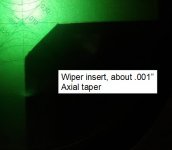DMF_TomB
Diamond
- Joined
- Dec 13, 2008
- Location
- Rochester, NY, USA
i got some new to me facemills and notices when sfpm get above 700 doing light cuts on cast iron the surface finish gets shiny
.
at edges dull for 1/2" till facemill warms up so i tried 850 sfpm and it gets surface more shiny closer to part edges.
.
i am just asking anybody notice what sfpm do carbide machined surface go from dull to extra shiny surface ? i am assuming it is the chips are hotter and reason surface are shiny.
.
obviously if facemill is throwing a lot of sparks it is going fast. basically shiny surface often happens just a little slower than when sparks start coming off facemill. inserts rated for up to 950 sfpm.
.
at edges dull for 1/2" till facemill warms up so i tried 850 sfpm and it gets surface more shiny closer to part edges.
.
i am just asking anybody notice what sfpm do carbide machined surface go from dull to extra shiny surface ? i am assuming it is the chips are hotter and reason surface are shiny.
.
obviously if facemill is throwing a lot of sparks it is going fast. basically shiny surface often happens just a little slower than when sparks start coming off facemill. inserts rated for up to 950 sfpm.






